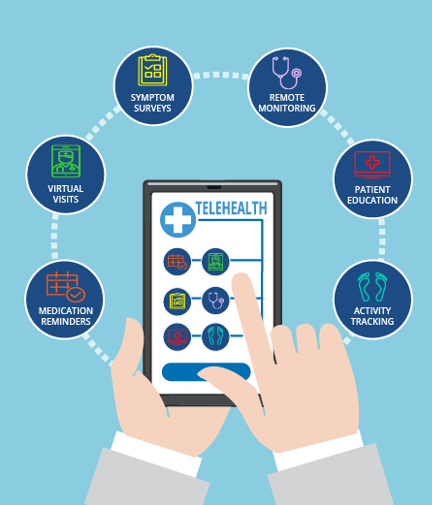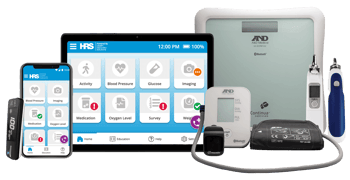While certainly an essential component of a robust telehealth program, virtual visits alone are not a telehealth strategy. Rooted in the foundation of a successful telehealth strategy is the notion that telehealth must enhance patient care by providing continuous connection and improved access (to primary care and specialty care). Virtual visits provide necessary check-ins and consultations, and absolutely improve access to healthcare across the continuum. However, they are only a small part of a larger strategy that healthcare organizations need to consider.
When building their digital strategy, providers must consider the other important components of a successful telehealth program such as remote patient monitoring via in-home devices, symptom surveys, educational videos, patient reminders, and activity tracking.
The Components of a Robust Telehealth Strategy
Virtual visits have become commonplace across the majority of healthcare organizations from small home health agencies, to midsize physician groups, to enterprise health systems. Many have replaced most of their in-person primary care visits and consultations with video visits. Additionally, with the expansion of virtual visit reimbursement, it is fair to assume that virtual visits’ popularity among patients and providers will continue to expand.
Virtual visits are an essential part of any telehealth strategy - they are a fantastic way to stay connected to patients and to ensure patients are receiving the care they need. However, it’s important to consider the many other telehealth components that make for a successful program for all patients.

Remote Patient Monitoring
Remote patient monitoring allows patients to stay at home and manage their chronic conditions resulting in reduced hospital readmissions, decreased ED utilization and ultimately, better overall health outcomes. When a patient is able to take their vitals and disease specific biometrics from home they are able to effectively self-manage their condition. For example, diabetic patients track their blood glucose with Bluetooth glucometers, COPD patients monitor their lung condition with connected spirometers, and THA/TKA patients track ambulation through wearables, a must for quick recovery. The clinician is able to monitor the readings, and communicate in real-time when necessary. Many organizations that utilize remote patient monitoring do virtual visits in conjunction with biometric monitoring.
An Example Use Case:
Tony is a 70 year old patient with hypertension and congestive heart failure. To ensure he remains healthy and at home, he is enrolled in a remote patient monitoring program. Twice a day, using Bluetooth devices, Tony records his blood pressure, weight, and pulse. The readings automatically upload to his device and transmit in real-time to Nurse Peggy’s portal. Tony and Peggy engage in weekly virtual check-ins to ensure Tony is complying with his care plan and to ensure he understands what behavior is expediting his recovery. If Peggy notices at-risk readings, she reaches out to Tony directly through the virtual visit platform to ensure everything is ok.
Patient Education
Health literacy and patient engagement are top predictors of improved patient outcomes. Just handing virtual visit technology to a patient likely won’t lead to improved outcomes. Patients need to understand both the importance of their engagement in the telehealth platform, as well as the specifics surrounding their condition. A robust telehealth program incorporates patient education via disease specific videos and quizzes directly into their care plan.
An Example Use Case:
Cassie, a 65 year old patient, recently underwent knee replacement surgery. She was enrolled in a telehealth program for the rehabilitation period, as she lives far from the clinic, and needs to engage in teleheatlh physical therapy. Cassie’s Physical Therapist, Benji, uploads information onto the telehealth platform explaining the steps to recovery, and why engaging in the platform is essential for her recovery and to gain full function of her knee. Benji also uploads Physical Therapy instructional videos, which walk Cassie through specific rehabilitative exercises for her knee. Through the clinician portal Benji is able to see when and if Cassie is engaging in the educational content. In addition to the educational content, Benji will be able to see how many steps Cassie takes each day because she is wearing a Bluetooth enabled wearable that transmits her steps on a daily basis.
Symptom Surveys
Symptom surveys are essential for tracking condition status and recovery progress. Used in conjunction with virtual visits, education, and remote monitoring, symptom surveys can help provide a full picture into the patient’s disease-state and their understanding of their condition. For a clinician to deliver consistent patient centric care, they must understand their patients day-to-day state and behaviors, not just how they’re feeling the day of their appointment (in-person or virtual).
An Example Use Case:
Miranda is a 30 year old patient with postpartum depression. Miranda was enrolled in the telehealth program by her Social Worker, Sadie, to ensure that the clinical team is able to track Miranda’s symptoms in real time through behavioral surveys. Sadie uploaded a custom symptom survey informed by the Beck Depression Inventory to the telehealth platform. Miranda answers the survey questions daily directly on the telehealth platform. Sadie is able to see Miranda’s responses on the clinical dashboard and intervene when necessary.
Patient Reminders
Patient reminders are essential for patient compliance. They help build habits resulting in behavior changes that improve health outcomes. Examples include medication reminders, bluetooth biometric and vital reading reminders, appointment reminders, and symptom survey reminders. Think of reminders as subtle nudges that reinforce and engrain the correct behavior in real-time. Without automated reminders the chances of an adverse event increase quickly for all patient populations.
Example Use Case:
Edward is a 45 year old patient with Type 2 diabetes, hypothyroidism, and mild depression. He is on several medications to manage his multiple diagnoses. His provider, Dr. Charlie enrolled him in the telehealth platform to ensure he remains compliant with his medications. Throughout each day, Edward receives medication reminders at various times, depending on the medication he is required to take. There are some medications that he takes multiple times a day, and others that he takes when he goes to bed at night. He receives reminders directly through the telehealth platform for all of the medications he is required to take. Before telehealth and the automated medications reminders, Edward would average 60% compliance with his medications. Today, his weekly medications compliance is 98%.

 Post-Pandemic Telehealth
Post-Pandemic Telehealth
The COVID-19 pandemic has triggered a rapid increase in telehealth adoption. The outbreak forced many healthcare organization’s to develop digital strategies in just weeks, when normally they’d do so over years. Many are still developing their strategies, while others are evaluating what they implemented at the offset of the outbreak. It is essential that providers carefully evaluate solutions that they can grow with for years to come and avoid adopting solutions that just fill one need. Having robust platforms that can be used across the continuum will expedite provider adoption, increase patient satisfaction and improve clinical outcomes.
Virtual visits are just one component of your strategy. They should be viewed as a component of a robust telehealth strategy that meets all of your patient’s unique needs. When virtual visits are used in tandem with the components provided above, they will undoubtedly be an essential component of a strong, profitable, and scalable telehealth program.